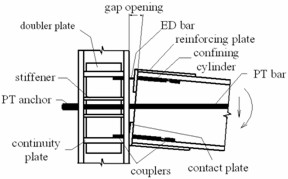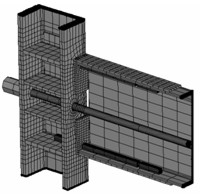
engineering & technology publications
ISSN 1759-3433
PROCEEDINGS OF THE EIGHTH INTERNATIONAL CONFERENCE ON COMPUTATIONAL STRUCTURES TECHNOLOGY
Numerical Modelling of PTED Connections for Steel Moment Resisting Frames
Department of Structural Analysis and Design, University of Naples "Federico II", Italy
The differences among the technical solutions proposed for realizing PTED connections essentially concerns the PT system and the ED system. Ricles et al. [1] have studied a connection based on high resistance steel strands as PT system and top-and-seat bolted steel angles as ED system. Christopoulos et al. [2] have studied a connection with high resistance steel bars as PT system and steel bars as ED system. The connection proposed by Rojas et al. [3] uses high resistance steel strands as PT system and friction devices as ED system.
This paper presents a finite element model, developed by the advanced software ABAQUS [4], of the PTED beam-to-column connection conceived and studied by Christopoulos et al. [2]. In particular, an external connection already analysed by experimental tests has been modelled in detail and subjected to a cyclic load history simulating the seismic action.
Figure 1a illustrates the scheme of the connection and Figure 1b shows the detail of the numerical model, which has been calibrated by means of the available results of the experimental tests [2], achieving a very good approximation. From the analysis of the cyclic behaviour of the connection the main peculiarities of the system have been pointed out, such as: contact and reinforcing plates have undergone inelastic deformations, therefore the use of high resistance steel is required; the energy dissipation capacity of the ED bars has been demonstrated, emphasizing their stable cyclic behaviour. Particular attention has been paid to the PT bars, which are responsible for the carrying capacity of the whole structural system: since they are characterized by a high stress concentration at the column holes, for large values of the system deformation, the importance of using low design stresses for the PT bars has been underlined.
Some further developments in the study of PTED connections have been illustrated, such as: the evaluation of the vertical load carrying capability, considering that the shear transmission is guaranteed by the friction at the beam-to-column interface; the comparison with both traditional and alternative PTED connections; the parametric analyses, which are useful for defining design criteria for the PTED connections; the study of steel frames equipped with PTED connections in the presence of both vertical and horizontal loads.
- 1
- J.M. Ricles, R. Sause, M.M. Garlock, S.W. Peng, L.W. Lu, "Experimental studies on post-tensioned seismic resistant connections for steel frames", in "Proceedings of Behaviour of Steel Structures in Seismic Areas (STESSA)", F.M. Mazzolani & R. Tremblay (eds), Montreal, Canada, 231-238, 2000.
- 2
- C. Christopoulos, A. Filiatrault, C.M. Uang, B. Folz, "Post-tensioned Energy Dissipating Connections for Moment-resisting Steel Frames", Journal of Structural Engineering, 128(9), 1-10, 2002. doi:10.1061/(ASCE)0733-9445(2002)128:9(1111)
- 3
- P. Rojas, J.M. Ricles, R. Sause, "Seismic Performance of Post-tensioned Steel Moment Resisting Frames with Friction Devices", Journal of Structural Engineering, 131(4), 529-540, 2005. doi:10.1061/(ASCE)0733-9445(2005)131:4(529)
- 4
- Hibbit, Karlsson and Sorensen, Inc., "ABAQUS/Standard, version 6.4", Providence, Rhode Island, USA, 2003.
- 5
- M. Esposto, B. Faggiano, F.M. Mazzolani, "Numerical analysis of PTED beam-to-column connection systems for steel MRFs", Proceedings of 20th CTA Conference, Ischia, Italy, 427-434, 2005.
- 6
- M. Esposto, B. Faggiano, F.M. Mazzolani, "Numerical vs. experimental results on a PTED beam-to-column connection for seismic resistant steel frames", in "Proceedings of Behaviour of Steel Structures in Seismic Areas (STESSA)" (submitted), Yokohama, Japan, 2006.
purchase the full-text of this paper (price £20)
go to the previous paper
go to the next paper
return to the table of contents
return to the book description
purchase this book (price £140 +P&P)

